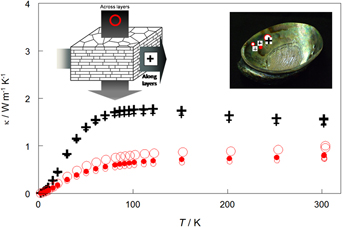Crossref Citations
This article has been cited by the following publications. This list is generated based on data provided by
Crossref.
Chen, Ran
Johnson, Michel B.
Plucknett, Kevin P.
and
White, Mary Anne
2012.
Thermal conductivity of tunable lamellar aluminum oxide/polymethyl methacrylate hybrid composites.
Journal of Materials Research,
Vol. 27,
Issue. 14,
p.
1869.
Wang, Zuyuan
Rolle, Konrad
Schilling, Theresa
Hummel, Patrick
Philipp, Alexandra
Kopera, Bernd A. F.
Lechner, Anna M.
Retsch, Markus
Breu, Josef
and
Fytas, George
2020.
Tunable Thermoelastic Anisotropy in Hybrid Bragg Stacks with Extreme Polymer Confinement.
Angewandte Chemie,
Vol. 132,
Issue. 3,
p.
1302.
Wang, Zuyuan
Rolle, Konrad
Schilling, Theresa
Hummel, Patrick
Philipp, Alexandra
Kopera, Bernd A. F.
Lechner, Anna M.
Retsch, Markus
Breu, Josef
and
Fytas, George
2020.
Tunable Thermoelastic Anisotropy in Hybrid Bragg Stacks with Extreme Polymer Confinement.
Angewandte Chemie International Edition,
Vol. 59,
Issue. 3,
p.
1286.
Li, Heng
Komatsu, Keiji
Nakamura, Atsushi
Ito, Osamu
Nambu, Keiki
and
Saitoh, Hidetoshi
2020.
Hydrogen adsorption and desorption characteristics of heat-treated calcium carbonate derived from Akoya-Pearl-Oyster nacre.
Journal of Environmental Chemical Engineering,
Vol. 8,
Issue. 4,
p.
103983.
Johra, Hicham
Margheritini, Lucia
Ivanov Antonov, Yovko
Meyer Frandsen, Kirstine
Enggrob Simonsen, Morten
Møldrup, Per
and
Lund Jensen, Rasmus
2021.
Thermal, moisture and mechanical properties of Seacrete: A sustainable sea-grown building material.
Construction and Building Materials,
Vol. 266,
Issue. ,
p.
121025.
Shrestha, Ranjit
Sfarra, Stefano
Ridolfi, Stefano
Gargiulo, Gianfranco
and
Kim, Wontae
2022.
A numerical–thermal–thermographic NDT evaluation of an ancient marquetry integrated with X-ray and XRF surveys.
Journal of Thermal Analysis and Calorimetry,
Vol. 147,
Issue. 3,
p.
2265.
Iyer, Divya
Galadari, Mohammad
Wirawan, Fernaldy
Huaco, Vanessa
Martinez, Ricardo
Gallagher, Michael T.
Pilon, Laurent
Ono, Kanji
Simonetti, Dante A.
Sant, Gaurav N.
and
Srivastava, Samanvaya
2024.
High-Strength Organic–Inorganic Composites with Superior Thermal Insulation and Acoustic Attenuation.
ACS Polymers Au,
Vol. 4,
Issue. 1,
p.
86.
Zhang, Xiao
Zhou, Jianyu
Wu, Kaijin
Zhang, Shuaishuai
Xie, Lili
Gong, Xinglong
He, Linghui
and
Ni, Yong
2024.
Simultaneous Enhancement of Thermal Insulation and Impact Resistance in Transparent Bulk Composites.
Advanced Materials,
Vol. 36,
Issue. 16,
Alderete, N. A.
Sathyan, S.
Raetz, S.
Margueritat, J.
Asgari, M.
Boechler, N.
Ghanem, M. Abi
and
Espinosa, H. D.
2024.
Characterization of the Phononic Landscape of Natural Nacre from Abalone Shells.
Small,
